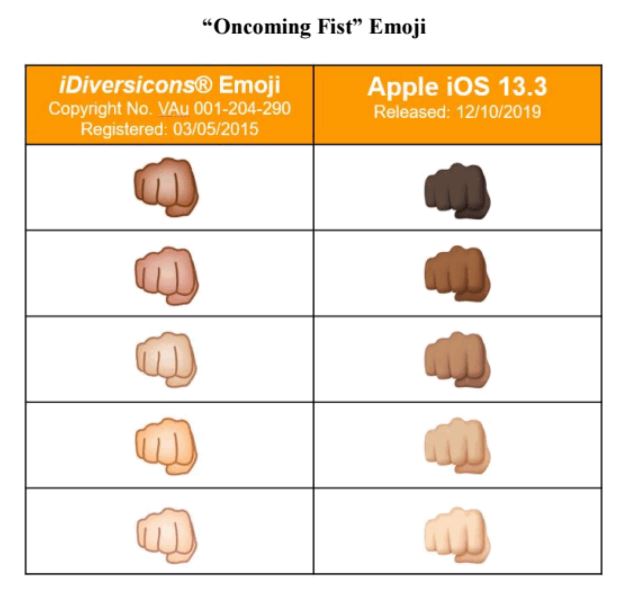Tutele negate dalla corte del nord della california 16.02.2022, Case No. 21-cv-06948-VC, Cub Club Investment c. Apple.
Il creatore di emoji <racially diverse> cita Apple che li aveva copiati, anche se con alcune differenze.
<<The copyrighted works are expressions of Cub Club’s idea of racially diverse emoji. Each of the emoji described in the complaint are variations on this theme, depicting body parts in certain positions (thumbs up; thumbs down; a fist; etc.) in varying skin tones. There aren’t many ways that someone could implement this idea. After all, there are only so many ways to draw a thumbs up. And the range of colors that could be chosen is similarly narrow—only realistic skin colors (hues of brown, black, and beige, rather than purple or blue) fall within the scope of the idea. Cub Club’s emoji are therefore “entitled to only thin copyright protection against virtually identical copying.” Mattel, 616 F.3d at 915>>.
Quelli di A. sono assai simili ma non identici: <<As alleged in the complaint, Apple’s emoji are not “virtually identical” to Cub Club’s. Compared side by side, there are numerous differences. Whereas Cub Club’s emoji are filled in with a gradient, the coloring of Apple’s emoji are more consistent. The shape of Apple’s thumbs-up emoji is cartoonish and bubbled, while Cub Club’s is somewhat flatter. Many of Cub Club’s emoji have shadows; Apple’s do not. Even the colors used are distinct—although both Cub Club and Apple have chosen a variety of
skin tones ranging from dark to light, the specific colors vary. These differences are sufficient to take Apple’s emoji outside the realm of Cub Club’s protected expression>.

Anche la tutela da trade dress (marchio di forma, o disegno, suppergiù) è negata e per ragioni simili, ovviamente: <<Cub Club’s allegations that the asserted trade dress goes beyond these functional elements to the “look and feel” of the product
is not enough to save its claim. “As a matter of law, a product’s ‘overall appearance’ is functional, and thus unprotectable, where the product is ‘nothing other than the assemblage of functional parts.’ ” Blumenthal Distributing, Inc., 963 F.3d at 866 (quoting Leatherman Tool Group, Inc. v. Cooper Industries, Inc., 199 F.3d 1009, 1013 (9th Cir. 1999)). In the absence of allegations identifying non-functional elements of Cub Club’s product, such a conclusory statement is not sufficient to plausibly allege that the asserted trade dress is non-functional>>
(notizia e link alla sentenza dal blog de lprof. Eric Goldman)